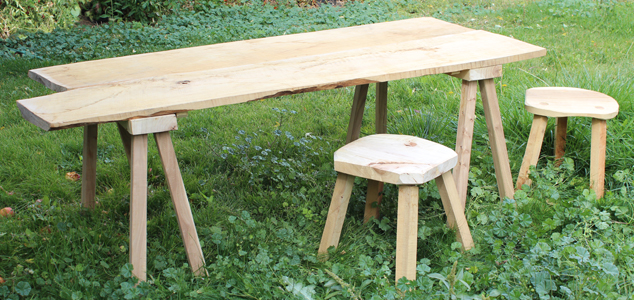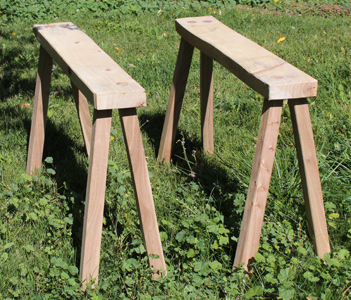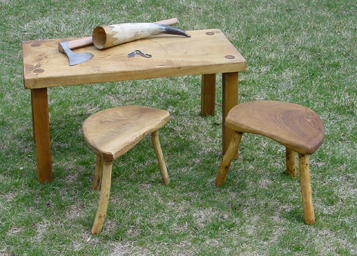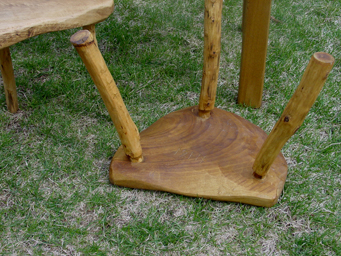

 I have built my new trestles (Saw Horses) for our camp table. The trestles are work horses and not furniture. As the camp is a transit location and high status accouterments would be unlikely to be brought. Multipurpose and likely grabbed from the work area, shipyard or barn. The table top, is a couple of boards.
I have built my new trestles (Saw Horses) for our camp table. The trestles are work horses and not furniture. As the camp is a transit location and high status accouterments would be unlikely to be brought. Multipurpose and likely grabbed from the work area, shipyard or barn. The table top, is a couple of boards.
The table will be used during the day for display of reproduction artifacts for public education, then after event hours, cleared for food preparation and meals.
The legs of the stools and trestles are elm and the trestle rails, stool seats and boards are cottonwood. (Yes, an American white wood, but in the same family as poplar and barely different in appearance.) The trestles are about 27.5" high making the table roughly 29" in height. The two stools are about 19" in height.
 This "table" is only 18" high, which means it can be used as a table or a bench. The Vikings normally did not have designated tables and chairs like we think of today but general purpose furniture that needed to fit into small work areas. The axe, horn and fire striker are placed there to give scale to the item.
This "table" is only 18" high, which means it can be used as a table or a bench. The Vikings normally did not have designated tables and chairs like we think of today but general purpose furniture that needed to fit into small work areas. The axe, horn and fire striker are placed there to give scale to the item.The two stools are crude "milking stools" which again filled the general need of "something to sit on, but the design of having a flat side is very particular to using it for milking cows. Though you see people on television placing the milk pail on the floor to milk, that only works with goats. Cows are too quick and if you don't have your pail gripped firmly between your legs, she will put her foot right into any bucket left on the floor. Believe me, they'll do that and look at you with a twinkle in their eye. Milker's need to grip the bucket as close to the crotch as possible and a stool with a round seat will not permit the pail to be gripped behind the knees but rather just between them. After about two minutes of milking the pail WILL slip right out and onto the floor. And she will look back with a twinkle in her eye.
Farmers today use the same stool for milking (If they do it by hand.) So if anyone tells you, "Well, we don't really know if it was used for milking..." here is what I know. WE used the same stool on the farm in my memory back to the 1950's, my father used the same stool back to the 1920's and his father used the same stool back to the 1890's. And so did our neighbor farmers. Yes, this is my version of the "Lund stool". The Viking milking stool.
POINT OF INTEREST! A recent movie (2009) was made using a modern stool of the same design in correct settings. A farmer built a set for the movie production crew, the stables and stools were sized for the comfort safety for the actors but they were filmed in the process of hand milking USING the three legged stool with the "D" shaped seat. They used it correctly, indicating they had the dairyman consulting on set. The movie was "Did You Hear About the Morgan's? - In New York City, an estranged couple who witness a murder are relocated to small-town Wyoming as part of a witness-protection program." Staring Hugh Grant, Sarah Jessica-Parker and Sam Elliot.
 Here I turned it upside down to let you see underneath. As a farmers son, I also saw the bottoms of stools, after being kicked out of the stall for no reason what-so-ever! Buckets flying and milk splashing over everything!
Here I turned it upside down to let you see underneath. As a farmers son, I also saw the bottoms of stools, after being kicked out of the stall for no reason what-so-ever! Buckets flying and milk splashing over everything! The table and stool's tops are all made of scrap poplar and the legs on the three legged stools are elm. The milking stools are about 13" high.
Here is a website that talks about making the Lund stool:
The 'Lund' Viking Stool: A Method of Replication By Stephen Francis Wyley
A construction opinion of my own, and comments on use of the stool.
The "D" shaped seat has a very specific purpose. Also the stools are shorter than regular seating stools so as the milker can fit under the cow comfortably. Though Viking age cows were shorter than modern cows, their udders where not so big as many of our modern breeds. The 13" tall stool is the correct height for milking, the single leg in the belly of the "D" goes to the back of the sitter. Once the milker is comfortably seated near the cow, you would lean into and under the udders. The single leg lifts as you lean in and you milk balancing on only two stool legs. As you finish, you shift back, onto three stool legs then stand up.
My point of this discussion is that I often see Lund stool replicas made with "D" shape seats but normal height legs. I feel those choices are made due to not understanding the stool is a PURPOSE BUILT tool. The "D" style seat in unneeded for any other stool, as there are no other uses of a stool where a pail needs to be gripped right up against the worker's crotch than milking a cow, which is a "close-in" task.